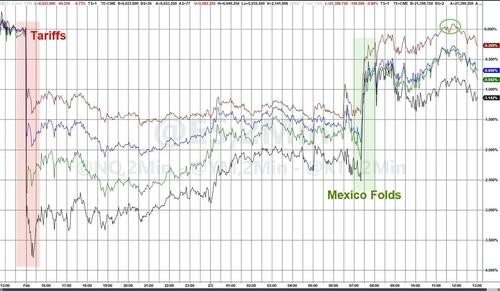
The overnight market experienced a "V-shaped reversal," and the market is more "confident" now. Did Goldman Sachs get it right again?

分析指出,市場對關税威脅持懷疑態度,將其視為典型的 “大棒加胡蘿蔔” 外交策略。隨着關税相關消息鋪天蓋地,美股早盤出現下跌,但科技巨頭跌幅有限。隨後,特朗普宣佈關税政策延期,市場果然出現了大逆轉,歐美股指和美債收益率跌幅迅速收窄。高盛樂觀指出,儘管前景不明朗,但針對加拿大和墨西哥的關税 “可能是短期的”。
特朗普關税威脅上演 “過山車”。
上週,特朗普的關税威脅使市場避險情緒升温。週一開盤,美股和歐股全線下跌,標普 500 指數一度跌超 1%。然而,關税政策很快出現反轉。據央視消息,美國總統特朗普週一與加拿大和墨西哥領導人通話後,同意將對這兩個鄰國徵收 25% 關税的計劃推遲一個月。市場情緒隨之緩解,歐美股指和美債收益率跌幅收窄。

分析指出,市場其實一開始就對特朗普的關税政策保持懷疑態度,該政策被市場視為典型的 “大棒加胡蘿蔔” 外交策略,關税威脅更多是談判籌碼,而非長期戰略,特朗普主要利用關税來獲取其他方面的讓步。這兩天隨着關税新聞鋪天蓋地,隔夜美股早盤出現了下跌,但科技股跌幅有限,於是盤初不久特朗普宣佈推遲關税計劃後,市場迅速鬆了一口氣,之後果然出現了大逆轉。
這一觀點呼應了高盛此前的預測,華爾街見聞此前文章指出,高盛首席經濟學家 Jan Hatzius 在其分析報告中表示,儘管前景不明朗,但針對加拿大和墨西哥的關税"可能是短期的"。
市場為何 “大逆轉”?
分析指出,市場一直 “自信” 認為特朗普將關税看做貿易談判的籌碼。畢竟在大選後,市場就曾誤判,押注他會先兑現減税和放鬆監管的承諾,再考慮關税措施。
市場對特朗普關税威脅持懷疑態度的原因有幾大方面:
其一,特朗普第一任期內,關税政策頻繁變動,支持了關税只是短期手段的觀點。
其二,關税會擾亂一些行業,如通用汽車股價一度下跌 6%,因為北美汽車業的跨境供應鏈高度一體化。
其三,SPI 資產管理公司 Stephen Innes 指出,“交易的藝術” 仍然是特朗普重要原則。特朗普一直密切關注美國股市表現,這可能影響其決策。
儘管目前形勢趨緩,但鑑於特朗普的反覆無常,交易員仍需保持警惕。正如一位華爾街分析師所言:“今天的胡蘿蔔可能明天就變成大棒。”未來市場繼續關注美、加、墨是否達成長期協議。如果這次延期僅是另一次"虛晃一槍",市場可能再次經歷劇烈波動,波動性將再度提高。
而且,關税可能成為長期政策的風險,主要有以下幾點值得警惕。一是特朗普多次提到用關税來幫助聯邦預算融資,這需要廣泛實施關税。二是他警告企業需要遷回美國,這隻有在永久性關税下才會發生。三是特朗普認為美國能夠承受經濟痛苦,“我們有所需的所有石油,我們有所需的所有樹木。” 這種韌性只有在長期關税下才顯得重要。
關税政策引發科技行業分化
特朗普關税政策在科技行業內引發了分化。隔夜,以谷歌、亞馬遜、Meta 和微軟為代表的科技巨頭,由於主要依賴雲計算、在線廣告等服務業務,受關税直接影響較小。這些公司的股價最大跌幅不超過 2%,與標普 500 指數的跌幅基本一致,展現出較強的抗壓能力。
但以特斯拉、英偉達和蘋果為代表的硬件生產企業則承受了更大壓力。這些公司依賴全球化的供應鏈和跨境貿易,關税政策帶來的不確定性直接影響其生產和銷售。週一,這三家公司股價分別在盤中下跌約 8%、6% 和 4%,儘管隨後有所回升,表現仍明顯弱於大盤。
分析稱,這種差異一是源於供應鏈和市場風險,例如,特斯拉依賴北美的汽車供應鏈,關税上調將擾亂生產佈局。蘋果在中國擁有龐大的生產和出口業務,英偉達在中國芯片市場佔有重要份額,貿易摩擦增加成本壓力。
二是估值壓力,蘋果、英偉達和特斯拉的市盈率分別高達 31 倍、30 倍和 131 倍。這些高估值使企業對未來盈利的預期高度敏感。任何政策變動都會放大市場對其盈利前景的擔憂,導致股價劇烈波動。

